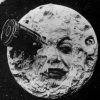How Meteors Magnetize the Moon
If you thought that the Moon and magnetism don't go hand-in-hand, think again. New satellite findings suggest that the Moon has magnetic anomalies, but how? While the moon doesn't have its own magnetic field, it's believed that the lunar rock orbiting our planet possesses magnetism due to an abundance of meteors and a lack of an atmosphere. As its countless craters indicate, the moon is constantly struck with meteors and other space debris. But there's more than an empty space that lies within these impact basins.
The Moon’s Magnetism
We’ve covered the moon’s magnetism before on this blog. Because it was once part of the earth, much of the moon’s mineral makeup is the same as our planet. That means iron. Lots and lots of iron. Iron is a ferromagnetic metal and thus produces a magnetic field. However, this requires a dynamo (gyrations caused by intense heat in the core that strengthen the magnetic field). Unfortunately, the moon’s core went cold and the dynamo stopped. In turn, this means the moon lost its magnetic field.
However, just because the moon is no longer churning out a magnetic field doesn’t mean there isn’t a good deal of residual magnetism. Recent satellite imaging has detected huge deposits of magnetism in lunar rocks, mostly in large craters. But how?
Here Come the Magnetic Meteors
Meteors are a common sight in the solar system. These little chunks of rock hurl through the vacuum of space until a planet or moon’s gravity pulls them in. So why isn’t the earth’s surface pocked with craters? It’s all thanks to our atmosphere. Due to the right cocktail of atmospheric gases, most meteors simply burn up before posing any danger to the planet below. However, the moon does not have an atmosphere, making it an open target for all those meteors.
Since the meteors aren't stopped by an atmosphere, they make it to the moon’s surface far more often. That’s why the moon has so many craters. Many of these meteors are also magnetic and as they slam into the moon, these chunks of space rock and the ground below are heated to the point of melting. At these temperatures, the already occurring magnetism in both the meteorites and moon rocks realign in a single direction.
It then stands to reason that bigger craters are more magnetic because they were hit with bigger meteors made of more magnetic materials. This theory might settle debates within the astrophysical community. For a long time, scientists have been perplexed by the moon’s numerous magnetic anomalies.
What to learn more about the wide world of magnetism? Visit the Magnets in the News section of our blog!

